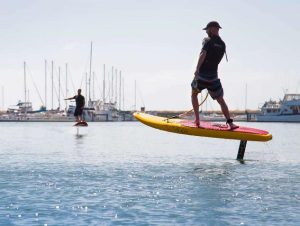Surfing's Evolution: From Traditional to Foil-Enhanced Boards
Surfing has long been a beloved pastime for water enthusiasts, with its roots deeply embedded in the culture of coastal communities worldwide. Over the years, the sport has seen significant advancements, particularly with the introduction of foil-enhanced surfboards. This article delves into the specifics of how these boards differ from traditional ones, providing a clear picture of the current state of surf technology.

Traditional Surfboards: A Legacy of Wood and Resin
Traditional surfboards, often crafted from wood or a combination of foam and resin, have been the backbone of the sport since its inception. These boards are known for their solid construction and the raw, unassisted surfing experience they offer. The average weight of a shortboard, a popular type of traditional surfboard, ranges from 4.5 to 7 pounds, providing surfers with a sense of connection to the waves.
Foil-Enhanced Surfboards: The Cutting Edge of Surfing Tech
In contrast, foil-enhanced surfboards represent a significant leap forward in surfboard design. These boards are equipped with a hydrofoil, a wing-like structure that, when submerged beneath the water, generates lift. This lift allows the board to plane over the water with less resistance, creating a smoother and more efficient ride. The use of foils has led to a new generation of surfers who can glide at lower speeds and in smaller waves, a feat not possible with traditional boards.
Performance Metrics: A Comparative Analysis
When it comes to performance, the numbers speak for themselves. Foil-enhanced boards have been recorded to increase a surfer's speed by up to 25% compared to traditional boards. Additionally, the lift provided by the foil means that surfers can catch waves with as little as 5 knots of wind, a stark contrast to the 15-knot minimum required for traditional boards.
The Environmental Impact: A Sustainable Future
Environmental considerations are also a key factor in the shift towards foil-enhanced boards. These boards are designed to be more energy-efficient, reducing the overall environmental impact of the sport. While traditional boards are often made from materials like polystyrene and polyurethane, which can take hundreds of years to decompose, foil-enhanced boards are increasingly being made with eco-friendly materials, paving the way for a more sustainable surfing future.
Adapting to the Wave: The Future of Surfing
As surfing continues to evolve, the adoption of foil-enhanced boards is becoming more prevalent. These boards offer a unique blend of performance and sustainability, pushing the boundaries of what is possible on the water. Whether you're a seasoned pro looking to up your game or a beginner seeking a smoother introduction to the sport, surfboard on water equipped with foil technology is a game-changer.
In conclusion, the transition from traditional to foil-enhanced surfboards marks a significant milestone in the history of surfing. With improved performance, accessibility, and environmental sustainability, the future of the sport looks brighter than ever. For those eager to experience this cutting-edge technology, consider exploring surfboard on water for more information and to get started on your foil-enhanced surfing journey.